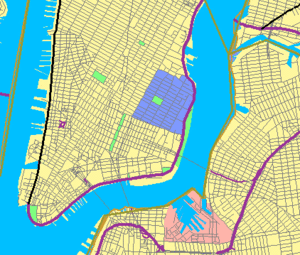District X
Written by David Hine, the series was a police procedural, starring Bishop and Ismael Ortega, who investigated crimes committed by and against the ghetto's mutant residents.
Margaret O'Connell, writing for Sequential Tart, describes District X as "the mutant ghetto of the Marvel Universe version of New York City", and as "a slum where minor-league mutants from all over the globe – often more visibly handicapped or disfigured by their genetic abnormalities than the relatively glamorous and outwardly normal X-Men – have congregated in a disaffected and varyingly dysfunctional clump.
"[5] Stories set in District X feature a range of mutant-owned businesses, clubs and restaurants, as well as a burgeoning mutant subculture.
Bands such as 'Sentinel Bait' and 'Juggernauts' are mentioned as parts of this subculture, while mutant fashion designers like Jumbo Carnation and nightclubs such as Daniel's Inferno create a vibrant, mutant-oriented nightlife.
"[6] David Brothers, writing for 4thletter!, notes that: Morrison turned mutants into a subculture, a logical extension of what happens when new elements are introduced into society.
In X-Factor, anti-mutant riots grip the district after the Decimation, with agents of the human supremacist group Purity roaming the area in X-Men: The 198.
The former 'Mutant Town' is later besieged by X-Cell, a terrorist group composed of former mutants who blamed the United States government for the loss of their powers.
Mutant Town is completely destroyed in X-Factor #31, 'The Middle East Side is Burning', as a 'back-up' plan by Arcade following his defeat.
A series of explosions incinerate much of the neighborhood, with Arcade's force fields preventing fire fighters from entering the area until the entire district is utterly annihilated.
The series stars the X-Man and FBI agent Lucas Bishop, assigned to the ghetto to investigate rising crime rates among the population in New York's (fictional) '11th Precinct' in Alphabet City.
Violence erupts between rival crime lords "Shaky" Kaufman and "Filthy Frankie" Zapruder over a mutant, Toad Boy, and the addictive narcotic he produces (known as 'Toad Juice').
After the death of a human patron at the nightclub Daniel's Inferno caused by exposure to Toad Juice, the police begin a desperate investigation before other unsuspecting addicts face the same fate.
This snaps the mutant back to his senses and he willingly returns to his peaceful life of quiet isolation after a short period in jail.
A series of brutal murders followed by a mysterious blackout leads to an investigation of the growing underground mutant community, called the Tunnel Rats.
In recent months, police and social services have put pressure on the Tunnel Rats by destroying their homes and remanding their children into state custody.
Tensions with the Tunnel Rats come to a head just as Bishop and Officer Ortega manage to track down The Worm, a hideously mutated young man who is seeking revenge for being cast out by his parents.
Academic Martin Lund, in the Journal of Urban Cultural Studies, stated that while District X was introduced during Morrison's run as part of the mutant subculture, it wasn't his main focus.
It did reappear in subsequent series such as writer Joe Quesada's NYX (November 2003–October 2005) with artists Joshua Middleton (#1–4) and Robert Teranishi (#5–7), however, NYX displayed continuity and geography errors such as District X appearing in the Lower East Side "rather than in Morrison's Alphabet City and, strangely, given Quesada's above-quoted emphasis on 'keeping the real world real', the Lower East Side's Essex Street was placed within the boundaries of Alphabet City.
Thus, although 'Mutant Town' did make a few appearances between its creation and District X, it was not until Hine, Yardin and Medina's series that the place became an area of sustained focus".
[9] Ashley Fields, for Screen Rant in 2023, commented that District X was "unique" among the various attempts at creating a mutant area, such as Genosha, Utopia, and Krakoa, within Marvel Comics since the idea was "that it was separated, yet still stuck with the constraints of human society.
Thus, District X condenses, mediates and puts a selection of urban problems on display – crime, drugs, homelessness, increased overcrowding and self-destructive desperation – and proceeds to show how official discipline provides their solution, telling readers that police intervention has the power to get rid of them".
[8] Lund commented that the series "tells readers that force in favour of clearing out radical difference in the neighbourhood and making it into a space fit for 'normal' people is natural, rational and logical and in the best interest even of those who might be displaced by gentrification, disproportionately incarcerated in the name of 'law and order', or put at risk of their lives in dangerous shelters.
